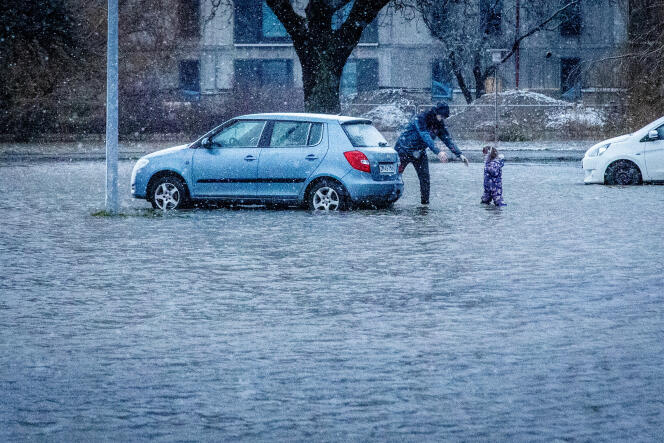


For almost three months, Brian Hansen, his wife and their two children have been living in a 34-square-meter prefab behind their large house, overlooking the marsh and beach, in the municipality of Solrod in southeastern Denmark. On October 19, 2023, the family was on vacation in Turkey, when the "storm of the century" hit the kingdom. Friends placed sandbags around the house. To no avail. As the sea level rose, exceeding two meters in some places along the coast, water seeped in through the large bay windows.
An executive at Motorola Solutions, Brian shows the marks on the wooden staircase: "There were 25 to 30 centimeters of water." The house had been completely renovated, before the family moved in 2016. "We learned about the risks, but we fell in love with the view, and never thought something like this would happen, at least not so quickly," admitted the man in his 40s, relieved to have escaped a second flood on the night of January 3-4. This time, the tide was lower than in October 2023, but the ground was waterlogged after record rainfall. (That year, 972.7 millimeters of rain fell in Denmark, 25% more than normal.) Several of his neighbors were also affected.
In just a few months, the Danes discovered what their future would look like. "Unfortunately, we have to prepare for more severe weather events like these in the future, especially with more water," warned Environment Minister Magnus Heunicke on January 5, stressing the "importance of accelerating coastal protection and climate adaptation in general."
Above all, these repeated floods have revealed the lack of preparedness in Denmark, one of the most vulnerable countries in Europe. With 7,300 kilometers of coastline (compared with 5,500 kilometers in mainland France), the kingdom of 5.9 million inhabitants is also the country with the second-lowest altitude in Europe, after the Netherlands.
"In the future, as sea levels rise, storms won't need to be particularly violent to cause events similar to what we've just seen," explained meteorologist Kristina Madsen.
According to her colleague Mark Payne, climatologist at the Danish Meteorological Institute, their frequency will depend on the intensity of global warming. "In the worst-case scenario, with a 50-centimeter rise in sea level, these events, which occur once every 20 years, will be 40 times more frequent by the end of the century. If the Paris Agreement is respected, they will occur seven times more often."
In Koge, in the neighboring municipality of Solrod, Jacob Thisted is unhappy. His garage, wedged between the main road and the sea, has been flooded twice in less than three months. With his five employees and two from the nearby technical inspection firm, he struggled for hours to hold back the water, without success. "Nobody came to help us, we were on our own," he grumbled, exasperated that the dike, promised by the municipality eight years ago, has still not been built.
You have 55% of this article left to read. The rest is for subscribers only.
